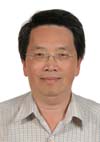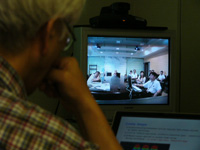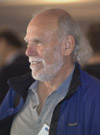 |
|
|
 |
A Perspective from Taiwan

Professor
Yee Bob Hsiung
|
Professor Yee Bob Hsiung obtained his PhD in physics in 1986 from Columbia University. He is an experimental particle physicist and has worked on many fixed target experiments at Fermilab, such as E605, E731, E773, E799 and KTeV, mostly concentrating on experiments on CP-Violation in neutral kaon decays. Currently, he is a collaborator of the Belle and E391A experiments at KEK and the CMS experiment at the CERN Large Hadron Collider.
Hsiung is a full professor of the Department of Physics at National Taiwan University (NTU). He is also leading the experimental particle physics efforts with several projects in the High Energy Physics Group of NTU Physics Department. His current interests in particle physics are CP-Violation in both kaon and B-meson decays, Higgs search as well as top production and decay at the LHC and the proposed ILC, and search for evidence of new physics beyond the Standard Model. In the ILC project, he focuses on the physics potential of the ILC, detector development as well as boosting the Asian participation.
He is one of the ILC contact persons in Asia for the Large Detector Concept (LDC) group. He and his group just joined the LDC group, so they have not yet decided which part of the LDC subdetector to work on. Currently, his group is interested in the silicon vertex detector, the small angle forward detector and detector simulations.
In August, Hsiung attended the second week of the Snowmass workshop. He felt the atmosphere of the workshop was very refreshing. "Around the world, there is very good progress in terms of the Linear Collider accelerator R&D, and the conceptual accelerator and detector designs, especially from KEK in the high-gradient superconducting RF cavity," he says. However, Hsiung thinks a two-week program might be too long for most scientists to attend, as the majority seemed to stay only for one week, either the first or the second week, of the Snowmass workshop. "It might be better to organize a one-week long workshop in the future," he suggests.
Hsiung expects that in the long run Taiwan might contribute funding for the ILC detector design, development and construction, and he also thinks that there might be areas in the accelerator components or electronics that the Taiwanese industry can contribute to. He says, "We do support the R&D of ILC, both in accelerator technology and detector concept, worldwide and also in Asia. However, due to the cost of the ILC and the current collider program at the LHC, we need to integrate a coherent program of ILC and LHC to find new physics in the coming decade."
--Kaoruko Saeki
|
 |
|
|
 |
Upcoming meetings, conferences, workshops
SMTF Collaboration Meeting
Fermilab, USA, 5-7 October 2005
Nanobeams 2005
Kyoto, Japan, 17-21 October 2005
European GDE Meeting
Oxford, England, 24-25 October 2005
ECFA ILC Workshop
Vienna, Austria, 14-17 November 2005
TESLA Technology Collaboration Meeting
Frascati, Italy, 5-6 December 2005
GDE Meeting
Frascati, Italy, 7-10 December 2005
2006 LCWS 2006
Bangalore, India, 9-15 March 2006
|
The ILC Asia group meeting

Japan, Korea, China/Taiwan, India were connected via videoconference for the ILC Asia group meeting 20 September.
ILC-Asia meetings
|
|
 |
 |
|
|
 |
Lessons from the LHC

Philippe Lebrun, head of the Accelerator Technology department at CERN |
The physics interplay between the LHC and the ILC has been discussed many times. But there are also technical and sociological similarities that are discussed less often. Philippe Lebrun is the head of the Accelerator Technology department at CERN, thus he has a unique view on both projects.
Both the LHC and the ILC are frontier projects, unique in the world, which will crystallize the efforts of the whole community for several decades. But in Philippe's opinion, the sociology of the ILC project is more challenging than it is for the LHC, because the ILC project starts without a host lab that acts as a focal point.
From a technical point of view, Philippe stresses two lessons learned during
the LHC construction that could be useful for the ILC:
(1) Do not underestimate the time and effort (and money!) needed for the industrialization phase, which begins after the R&D phase and before series production. For the LHC superconducting cables and magnets, this proved to be as long as (if not longer than) the series production proper.
(2) Always maintain sufficient in-house (host lab) competence in key technologies and support techniques to be ready to cope with technical, schedule or financial failure of industrial contractors. The characteristic time of the project construction often exceeds the lifetime of industrial companies, i.e. the project will have to live through and recover from such crises.
--Nicolas Delerue
|
 |
|
|
 |
From symmetry magazine,
September 2005 issue
Niobium
More than 500 tons of niobium would go into building the ILC. What's so great about niobium? Where does it come from? And is the Earth's supply going to run out?
Araxá, Brazil, sits atop the world's largest supply of niobium. As far as particle physicists are concerned, it might as well be a gold mine. The future International Linear Collider (ILC) would use over 500 tons of pure niobium to build 20,000 superconducting radio-frequency (rf) cavities, devices that accelerate electrons and their antimatter twins, positrons, along microwaves to near-light speeds.
That means metal-refining factories would have to work at full capacity for three to four years solely to create highly-refined niobium for the ILC. Currently at three hundred dollars a pound, the niobium alone would cost the ILC upwards of three hundred million dollars—though technological developments might reduce the price tag. And it's all in the name of superconductivity.
Superconductors
At 9.2 Kelvin, niobium acts as a superconductor— a substance with no electrical resistance. In these materials, electrons move more smoothly than skates on ice. But cooling the materials isn't easy. The process requires isolating the metal in a vacuum chamber and using liquid helium as a coolant. Because niobium superconducts at a temperature warmer than any other metal, it's the easiest to cool. That's why it's attractive.
Using niobium in accelerators isn't anything new. Scientists at the Westinghouse Electric Company developed niobium-titanium superconducting wire in 1962; soon after, Rutherford Appleton Laboratory scientists used the wire to design magnets. Fermilab's Tevatron, a superconducting accelerator, first used these magnets in 1987. A host of accelerators followed suit.
However, ILC's superconducting rf cavities would be solid niobium. The difference lies in each instrument's purpose: magnets guide particle beams, whereas rf cavities accelerate them.
Read more
|
|
 |
 |
|
|
 |
Partnerships with Industry
It is important for all of us who are developing the technologies, designs and plans

Barry Barish
|
for the ILC to recognize that the majority of the construction of the actual machine will be done by industry. This will be true for constructing the conventional facilities, for fabricating the superconducting RF cavities and for producing most of the other elements going into this sophisticated accelerator. For this reason, the earlier we begin our partnerships with industry the more we will be able to use industry to help us optimize our designs, and the smoother will be the technology transfer to industry.
The GDE has been involved in hosting two meetings for industry in the past month, one at Snowmass and a second meeting last week at Fermilab that was well covered in last week's ILC NewsLine. In addition, I personally saw an impressive industrial poster exhibit at DESY, during the time of the ITRP process, and early this summer I had the opportunity to give a special ILC presentation to the Japanese Industrial Forum in Tokyo. Overall, I feel we have made a very good start in developing our relationships with industry. In this week's column, I would like to add a few more comments about the importance of industry to the ILC and to the GDE process, and also give my view of how I see our relationships with industry developing in the coming few years.
The first question I might answer is how we plan to use industry in the development of the Reference Design over the next year or so. In immediate terms, we plan to use industry to help us do some of the costing, especially for the major cost drivers. Also, integral to our strategy for making a realistic design report, we plan to develop models for how we could build the ILC and we will then cost those models. To accomplish this, we will need to have some idea as to how we might divide up responsibilities into work packages and how we would carry out these work packages. Developing such models will allow us to study different ways we might approach the construction of the ILC, and in particular how we will use industry. Finally, we will need to work with industry to do the technology transfer and to develop through industry better ways to build crucial components.
Read more
--Barry Barish
Director's Corner Archive
|
 |
|
|
 |
European GDE Meeting
The European GDE members will meet at Oxford University, England,
24-25 October 2005 to discuss matters of specifically European
interest, in particular optimisation of R&D and preparation for
further bids to the EU and elsewhere, and outreach. There will
be a dinner on the night of 24 October. Accommodations can
be arranged in Oxford, either in a hotel or a guest room in a college.
The meeting is intended for European GDE members, but all GDE members
are invited to attend. If you would like to attend, respond to
Brian Foster
and Sue Geddes by October 10.
SMTF Collaboration Meeting, 5-7 October 2005
There will be an SMTF Collaboration meeting at Fermilab on 5-7 October
2005. Barry Barish and Gerry Dugan will attend the first day of the meeting
and participate in some of the working group discussions. A proposed
agenda is still being written and will be available on the ILC
Web site soon. Stay tuned to ILC NewsLine for more information
about this meeting.
View agenda
ILC Jobs
Several ILC job openings are now posted on the ILC Web site.
If you have a job opening that you would like posted, send it to webmaster@ilcgde.org.
Recent ILC Related Preprints
hep-ph/0509196 - Supersymmetric Heavy Higgses at e^+e^- Linear Collider and Dark-Matter Physics, 20 Sept. 2005
hep-ph/0509199 - Measuring Dark Matter at Colliders, 20 Sept. 2005
hep-ph/0509309 - ILC Cosmology, 27 Sept. 2005
hep-ph/0509277 - Identifying the contributions of Universal Extra Dimensions in the Higgs sector at linear e+ e- colliders, 26 Sept. 2005
ATF Proposal - KEK Report 2005-9
If you recently released a preprint related to the ILC,
let us know!
|
|

